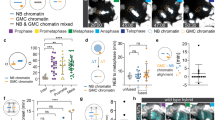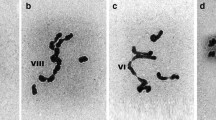Abstract
In translocation T(IL→VL)OY321 of Neurospora crassa a distal portion of the nucleolus organizer chromosome, including ribosomal DNA sequences and the nucleolus satellite, is interchanged with a long terminal segment of IL. When OY321 is crossed by Normal sequence, one-fourth of the meiotic products are segmental aneuploids that contain two copies of the long IL segment and that are deficient for the distal portion of the organizer. Each such product forms a nucleolus and is viable. The complementary aneuploid products are deficient for the IL segment and are therefore inviable. — In crosses of OY321xOY321, each product is capable of making two nucleoli; nucleoli formed by the separated nucleolus organizer parts usually fuse, but most 8-spored asci contain some nuclei in which two separate nucleoli can be seen. One nucleolus is then terminal on its chromosome while the second is interstitial and somewhat smaller. — In crosses of OY321 x Normal, half of the meiotic products are capable of making two nucleoli. However, only about 15% of 8-spored asci have one or more nuclei containing separate nucleoli. At pachytene and later in prophase I, the single fusion nucleolus is associated with three bivalent chromosome segments. Each nucleus of every ascus contains at least one nucleolus, even in asci where some nuclei display two nucleoli. — Crosses of Aneuploid x Normal are usually semibarren, producing a reduced number of ascospores, some of which are inviable. Some aneuploid cultures become fully fertile by reverting to a quasinormal sequence lacking a satellite. In some crosses of Aneuploid x Normal, individual asci may show at prophase I either complete loss, partial loss, or pycnosis of the translocated IL segment. This observation of pycnosis suggests chromosome inactivation. — Growth from aneuploid ascospores is initially slow, but can accelerate to the wild-type rate.
Similar content being viewed by others
References
Anastassova-Kristeva M, Nicoloff H, Künzel G, Rieger R (1977) Nucleolus formation in structurally reconstructed barley karyotypes with six satellite chromosomes. Chromosoma 62:111–117
Barry EG (1966) Cytological techniques for meiotic chromosomes in Neurospora. Neurospora Newsl 10:12–13
Barry EG, Perkins DD (1969) Position of linkage group V markers in chromosome 2 of Neurospora crassa. J Heredity 60:120–125
Free SJ, Rice PW, Metzenberg RL (1979) Arrangement of the genes coding for ribosomal ribonucleic acids in Neurospora crassa. J Bacteriol 137:1219–1226
Gillies CB (1972) Reconstruction of the Neurospora crassa pachytene karyotype from serial sections of synaptonemal complex. Chromosoma 36:119–130
Gillies CB (1979) The relationship between synaptonemal complexes, recombination nodules and crossing over in Neurospora crassa bivalents and translocation quadrivalents. Genetics 91:1–17
Krumlauf R, Marzluf GA (1980) Genome organization and characterization of the repetitive and inverted repeat DNA sequences in Neurospora crassa. J Biol Chem 255:1138–1145
McClintock B (1934) The relation of a particular chromosomal element to the development of the nucleoli in Zea mays. Z Zellforsch 21:294–328
Mylyk OM, Barry EG, Galeazzi DR (1974) New isogenic wild types in N. crassa. Neurospora Newsl 21:24
Perkins DD (1974) The manifestation of chromosome rearrangements in unordered asci of Neurospora. Genetics 77:459–489
Perkins DD, Barry EG (1977a) The cytogenetics of Neurospora. Adv Genet 19:133–285
Perkins DD, Barry EG (1977b) Information on chromosome rearrangements. Neurospora Newsl 24:12–13
Perkins DD, Raju NB, Barry EG (1980) A chromosome rearrangement in Neurospora that produces viable progeny containing two nucleolus organizers. Chromosoma 76:255–275
Phillips RL (1967) The association of linkage group V with chromosome 2 in Neurospora crassa. J Hered 58:263–265
Phillips RL (1978) Molecular cytogenetics of the nucleolus organizer region. In: Waiden DB (ed) Maize breeding and genetics, Wiley, New York p 711–741
Phillips RL, Wang SS (1972) Cytological localization of interchange breakpoints to the nucleolus organizer region or satellite. Maize Genet Coop Newsl 46:123
Phillips RL, Weber DF, Kleese RA, Wang SS (1974) The nucleolus organizer region of maize (Zea mays L.): Tests for ribosomal gene compensation and magnification. Genetics 77:285–297
Phillips RL, Wang AS, Kowles RV (1983) Molecular and developmental cytogenetics of gene multiplicity in maize. Stadler Genet Symp 15 (in press)
Raju NB (1980) Meiosis and ascospore genesis in Neurospora. Eur J Cell Biol 23:208–223
Raju NB, Newmeyer D (1977) Giant ascospores and abnormal croziers in a mutant of Neurospora crassa. Exp Mycol 1:152–165
Rodland KD, Russell PJ (1982) Regulation of ribosomal RNA cistron number in a strain of Neurospora crassa with a duplication of the nucleolus organizer region. Biochim Biophys Acta 697:162–169
Rodland KD, Russell PJ (1983) Segregation of heterogeneous rDNA segments during demagnification of a Neurospora crassa strain possessing a double nucleolar organizer. Curr Genet 7:379–384
Ryan FJ, Beadle GW, Tatum EL (1943) The tube method of measuring the growth rate of Neurospora. Am J Bot 30:784–799
Shear CL, Dodge BO (1927) Life histories and heterothallism of the red bread-mold fungi of the Monilia sitophila group. J Agric Res 34:1019–1042
St Lawrence P (1954) The association of particular linkage groups with their respective chromosomes in Neurospora crassa. Ph D thesis, Columbia University, New York 1952 (Abstracted in Diss Abstr 14:7–8)
Author information
Authors and Affiliations
Rights and permissions
About this article
Cite this article
Perkins, D.D., Raju, N.B. & Barry, E.G. A chromosome rearrangement in Neurospora that produces segmental aneuploid progeny containing only part of the nucleolus organizer. Chromosoma 89, 8–17 (1984). https://doi.org/10.1007/BF00302344
Received:
Issue Date:
DOI: https://doi.org/10.1007/BF00302344




